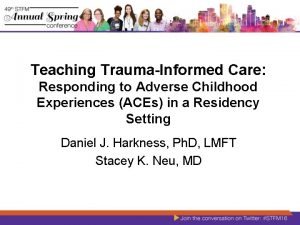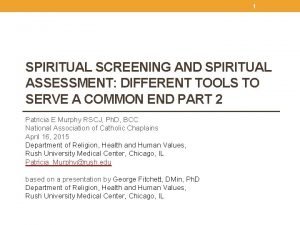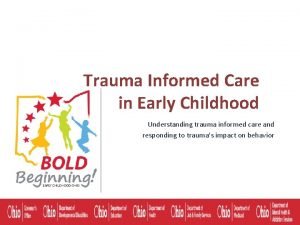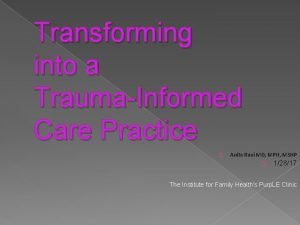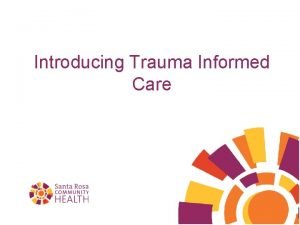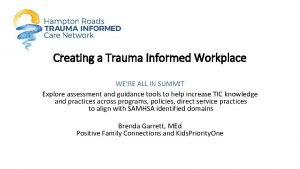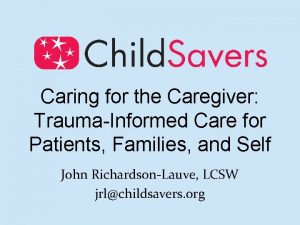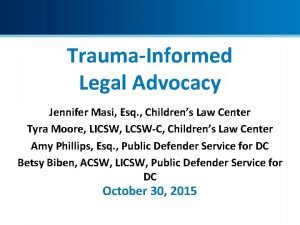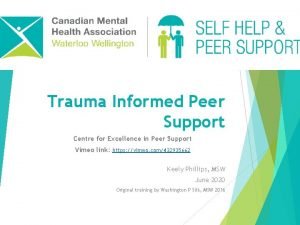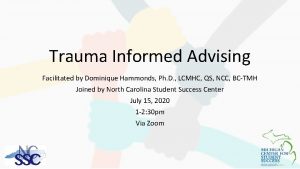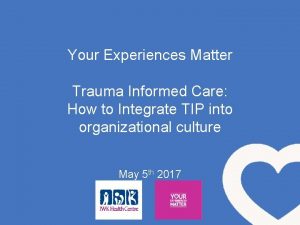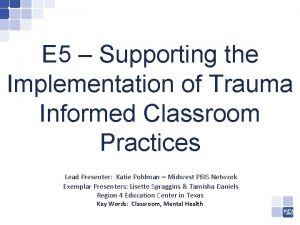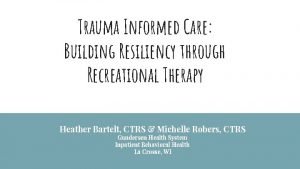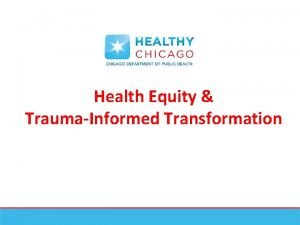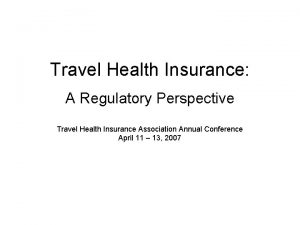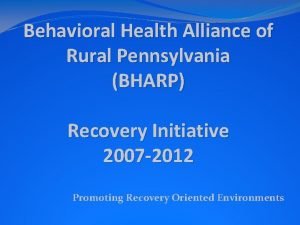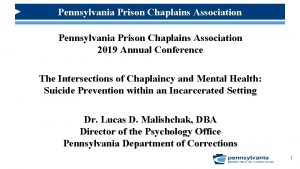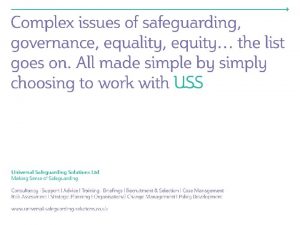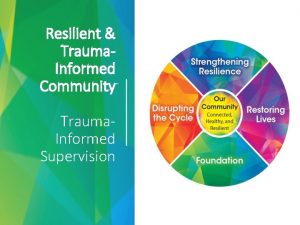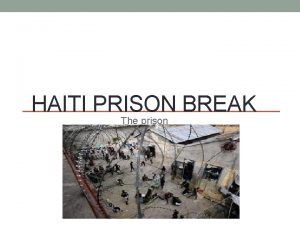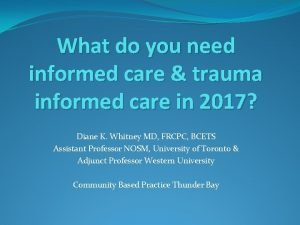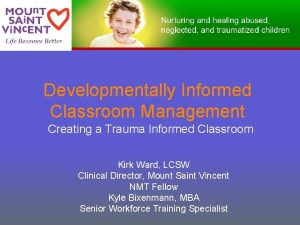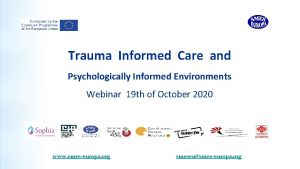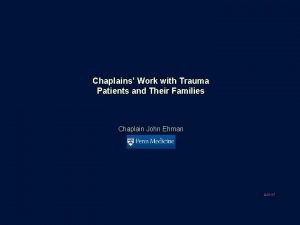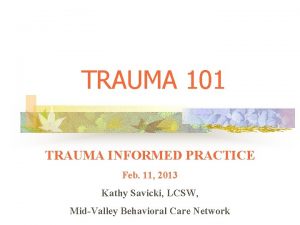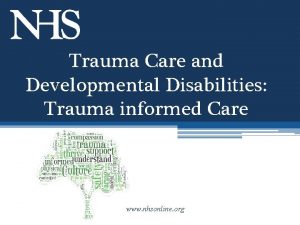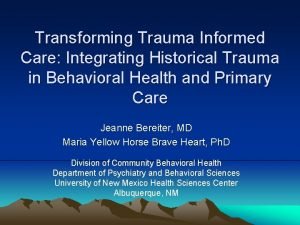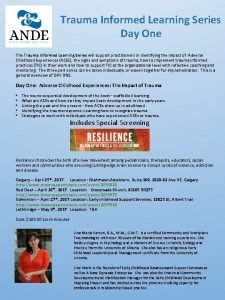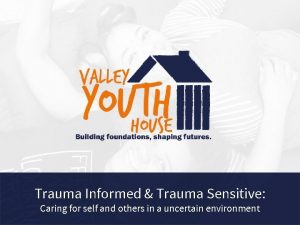Trauma Informed Approach Pennsylvania Prison Chaplains Association Conference







































- Slides: 39

Trauma Informed Approach Pennsylvania Prison Chaplains Association Conference September 17, 2019 Lynn A. Patrone Forensic Mental Health Advocate

Performance Objectives • • • Define trauma Describe effects and reaction to traumatic events Understand the risk factors for suicide and trauma Understand the principles of a trauma informed approach Define the resilient factors of trauma

How We Think…. Affects How We Respond

Brain takes in information and determine if the threat is valid. Brain now recognizes that there is no longer danger. You are interacting with an individual and he /she becomes very agitated or threatening. He/she accuses you of not listening or helping. Brain initiates the fight, flight or freeze response. Brain sends a message that there is an emotional or physical threat which sets off a warning. Response is informing the individual that you will not communicate with them or sending them away. Rational/thoughts are taken over by the emotional brain.

Let’s Talk About The Who? ? ?

Who Experiences Trauma • 11 to 20 percent of veterans who served in Operations Iraqi Freedom or Enduring Freedom and about 12 percent of veterans who served in the Gulf War have PTSD in a given year; • 23 percent of female veterans who use VA health care services report having experienced sexual assault while in the military. How Common is PTSD? National Center for PTSD, U. S. Department of Veterans Affairs, 2015 6

Characteristics of Trauma • • Single event Recurring event(s) Continual exposure Mental illness/substance use Processing (cascading trauma) Loss Support 7

Bureau of Justice Statistics • State incarceration and Mental Illness (MI) • 2 x more likely to have been homeless within 1 year before their arrest; • County custody and MI • 2 x more likely to report physical or sexual abuse in their past.

Mac. Arthur Mental Health Court Study • 70% women & 25% men report sexual abuse/rape before age 20; • 46% women & 27% men saw parents act violent toward each other; • 61% women & 68% men beat by parents; • 67% women & 73% men physical abuse; • 34% women & 32% men experienced physical or sexual abuse within the past 12 months. https: //www. youtube. com/watch? v=K_WL 5 iqv. Pl. Y

Trauma and Culture • Certain populations may experience higher rates of trauma; • Culture influence how an event is perceived and the response; • May disrupt the culture; • May impact access to support.

Trauma Informed Approach • Realizes the widespread impact of trauma and understands potential paths for recovery; • Recognizes the signs and symptoms of trauma in clients, families, staff, and others involved with the system; • Responds by integrating knowledge about trauma into policies, procedures, and practices; and • Resist re-traumatization.

SAMHSA’s Six Key Principles • • • Safety Trustworthiness and Transparency Peer support Collaboration and mutuality Empowerment, voice and choice Cultural, Historical, and Gender Issues 12

What Defines a Trauma 3 E’s-Event(s) Experience Effects • An overwhelming event or series of events experienced by an individual • Not the event alone that impacts the person but the experience and the response • Can be physically, emotionally and psychologically harmful • May cause fear, helplessness, vulnerability or terror

Various Types 14

15

16

Political/War Trauma 17

18

Adverse Childhood Experiences (ACES) • Occur within a certain period of development • Influence later development • Physical • Mental • Emotional • • • Neglect Physical Emotional Sexual Impacts adulthood Risk for recurring trauma exposure

Children are not mini adults 20

Effects of Trauma • Early traumatic events such as abuse, neglect and other forms of trauma can: • Result in biological/psychological changes and stress responses; • Increase a person’s vulnerability to encountering interpersonal violence as an adult; • Overwhelms the ability to utilize cognitive, emotional, physical and positive coping skills 21

Trauma Resistance Lazy/unmotivated Manipulative/always looking to get something Disrespectful Antagonistic Seeking attention Uncaring/lacks empathy Trauma Informed Approach

Biological Impact of Trauma Let’s look at 3 areas of the brain impacted by trauma • Amygdala • Pre-frontal cortex • Hippocampus 23

Physiological Impact • Changes in the limbic system • Nerves in the brain that drive mood and emotions such as fear, pleasure, anger. • Hyperarousal • Increase risk of developing chronic diseases/other physical illnesses, mental illnesses/substance-related disorders

Physical effects • • • Somatic complaints Sleep disturbances Gastrointestinal Cardiovascular Musculoskeletal Respiratory Dermatological Urological problems Substance abuse disorders STDs

Psychological Effects • Depression • Suicide • Anxiety • Panic attacks • Nightmares, flashbacks, sleep issues • Isolation

Psychological Responses to Trauma • Responses • Fight/flight response • Confusion • Dissociation/blunted affect • Acute Stress Disorder (ASD) • Prolonged experiences of distress, lack of feeling calm, intrusive thoughts • Nearly 1/3 of survivors experience symptoms that interfere with lives after several weeks and lasts from 2 days up to a month • Post Traumatic Stress Disorder • More than a month • Untreated ASD may lead to PTSD

BEHAVIOR = SURVIVAL

Behavioral Effects • Self injury-cutting, burning, punching, head banging, inserting objects, PICA • Substance use/self-medicating • Impulsive behavior • Overeating • Poor relationships • Avoidance/anxiety • Aggressiveness • May be learned from the event or be a result of the event

Cognitive Effects • • • Avoidance Suspicion of others/constantly “on guard” Feelings of helplessness Cynical, accusatory/irritable Can alter ability to reason, rationalize Impacts the daily world/life around a person Feeling different than other people May believe that others could never understand Shame, guilt Triggers 30

Emotional Impact • Emotional Dysregulation-difficulty regulating their emotions • Occurs more often when trauma occurred at a young age • Usually short-lived in older survivors who were functioning well before the trauma • May experience shame, anxiety, sadness, guilt • Numbing-biological process • Emotions are detached from thoughts, behaviors and memories 31

Why do different people react differently to traumatic events? RISKS RESILIENCE • • Family ties • Strong primary relationship • Connection to community • Employment • Meaningful activity • Strong cultural or religious beliefs Health issues Pre-existing MH problems Severity of trauma Proximity of trauma Biology Numerous traumas Experiences that diminish coping capacity 32

Paradigm Transference “What's wrong with me? ” Recognize the resilience “What happened to me? ” 33

Resilience • Can lead to evaluating one’s life/values • • Increased connections to family/community Redefine purpose or meaning Re-establish priorities Advocacy

“Secondary Trauma” • Trauma-related stress reactions/symptoms resulting from exposure to another individual’s traumatic experiences • Not from exposure directly to a traumatic event • Risk factors: • • • Anxiety/stress or mood disorders Prior personal trauma Substance use Compassion fatigue/vicarious trauma/burnout Lack of healthy coping skills

“Secondary Trauma” • Are you noticing…… • Depression, anxiety, somatic complaints, numbing substance use, disordered eating, avoidance • Vulnerability or feeling increased vulnerability • Cynicism • Helpless • Accusatory • Relationship troubles • Detachment • Countertransference • Being judgmental • Decrease in socialization • Loneliness • Change in personal fundamental principles • Disconnection from personal interests

Components of Self Care Preventing Secondary Trauma v Physical v Emotional v Spiritual v Psychological • • • Peer/social support Consultation Training Counseling/psychotherapy Balance

Quote to Ponder… • “Many abused children cling to the hope that growing up will bring escape and freedom. • But the personality formed in the environment of coercive control is not well adapted to adult life. The survivor is left with fundamental problems in basic trust, autonomy, and initiative. She approaches the task of early adulthood establishing independence and intimacy burdened by major impairments in self-care, in cognition and in memory, in identity, and in the capacity to form stable relationships. • She is still a prisoner of her childhood; attempting to create a new life, she reencounters the trauma. ” Judith Lewis Herman, Trauma and Recovery: The Aftermath of Violence - From Domestic Abuse to Political Terror

References • • Blum, D. . (2002). Love at Goon Park: Harry Harlow and the science of affection. New York: Basic Books. Herman, J. (1992). Trauma and recovery; the aftermath of violence – from domestic abuse to political terror. New York: Basic Books. Nash, M. (10/13/2000). Medicine: Not So Dopey Dopamine. Time Magazine. Van der Kolk, B. (2014). The body keeps the score: Brain, mind, and body in the healing of trauma, New York: Viking. Van der Kolk, B. , Mc. Farlane, A. C. , and Weisaeth, L. (1996). Traumatic stress: the effect of overwhelming experience on mind, body, and society. New York: Guilford Press. Substance Abuse and Mental Health Services Administration, Trauma Informed Care in Behavioral Health Services. Treatment Improvement Protocol (TIP) Series 57. HHS Publication No. (SMA) 14 -4816. Rockville, MD: Substance Abuse and Mental Health Services Administration 2014. https: //www. ncjfcj. org/sites/default/files/Finding%20 Your%20 ACE%20 Score. pdf (ACES Quiz) Understanding Trauma and Its Impact Activity. Packethttps: //safesupportivelearning. ed. gov/sites/default/files/Trauma_101_Activity_Packet. pdf.
 Trauma informed approach
Trauma informed approach 7 x 7 spiritual assessment model
7 x 7 spiritual assessment model 4 r's trauma informed care
4 r's trauma informed care Lgbt trauma informed care
Lgbt trauma informed care Dr anita ravi
Dr anita ravi Trauma-informed care activities for staff
Trauma-informed care activities for staff Trauma-informed workplace assessment
Trauma-informed workplace assessment Trauma-informed questions for clients
Trauma-informed questions for clients 4 r's trauma informed care
4 r's trauma informed care Trauma informed legal advocacy
Trauma informed legal advocacy Kobtion
Kobtion Www.dfps.state.tx.us/training/trauma informed care/
Www.dfps.state.tx.us/training/trauma informed care/ Tina champagne sensory modulation and environment
Tina champagne sensory modulation and environment Trauma informed advising
Trauma informed advising Trauma informed parenting discipline
Trauma informed parenting discipline Trauma informed practice
Trauma informed practice Trauma informed physical environment
Trauma informed physical environment Trauma-informed care cheat sheet
Trauma-informed care cheat sheet Trauma informed practice
Trauma informed practice Trauma informed care for foster youth
Trauma informed care for foster youth Pennsylvania forest products association
Pennsylvania forest products association Pennsylvania association of school business officials
Pennsylvania association of school business officials Certified clinical trauma professional
Certified clinical trauma professional Oak schuetz
Oak schuetz Travel health insurance association annual conference
Travel health insurance association annual conference Defense orientation conference association
Defense orientation conference association Pa state plane zones
Pa state plane zones Atlantic coastal plain pennsylvania
Atlantic coastal plain pennsylvania Rachel carson was born in 1907 in springdale pennsylvania
Rachel carson was born in 1907 in springdale pennsylvania Pennsylvania
Pennsylvania Xoom energy pennsylvania
Xoom energy pennsylvania Pa new hire reporting
Pa new hire reporting New york, new jersey, pennsylvania, and delaware
New york, new jersey, pennsylvania, and delaware Sandata training
Sandata training My uncle from pittsburgh pennsylvania
My uncle from pittsburgh pennsylvania Behavioral health alliance of rural pennsylvania
Behavioral health alliance of rural pennsylvania Amerihealth caritas pennsylvania community healthchoices
Amerihealth caritas pennsylvania community healthchoices Pennsylvania ecosystems
Pennsylvania ecosystems Pennsylvania dutch council
Pennsylvania dutch council Modern real estate practice in pennsylvania
Modern real estate practice in pennsylvania
